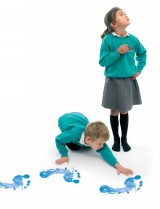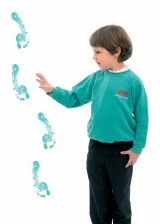Introduce some mysterious goings on to your classroom, suggests Bruce Potts. Children’s natural curiosity will sustain their learning...
Anthropologists have found there is no society in the world whose children do not play hide and seek. It’s not surprising, as from the moment children begin to notice others around them they love the idea of hiding and things being hidden. Who, after all, hasn’t made a baby gurgle with pleasure by playing Peekaboo?
In primary schools young learners have always loved using things like ‘feely bags’ or ‘feely boxes’ in a variety of different ways. But why stop there? Using the following ideas you can create mysterious events in your classroom that will fascinate children all year round.
 The visitor…
The visitor…
After the children have gone home at the end of the day, prepare a set of sugar paper footprints (any colour) and attach these to the wall above the classroom entrance, continuing across the ceiling and exiting through another door at the other side of the room. The idea is to create the impression that someone has entered the classroom, walked up the wall, across the ceiling and out the other side.
Next day, just wait to see the reaction of the children when they see the footprints. It will provoke an enormous amount of discussion, led by yourself, as you play along with the ‘mystery’ of who visited during the night.
This can be a great starting point for a piece of imaginative writing, and once the children’s imaginations are really bubbling you’ll find the quality of their writing moves to another level.
For children who write slowly - but who have lots to say - give them the chance to dictate their piece of work into a voice recorder for later transcription. This will ensure their ideas are not lost if there isn’t time to write them all down.
The great dig
To get your term’s health and fitness topic off to a great start, bury a few ‘dinosaur’ bones (you can buy plastic bones from various places, but the Natural History Museum will help you out if you’re stuck) around the school grounds, being careful not to locate them anywhere that will upset your colleagues! You could also consider making a plaster cast of a dinosaur footprint and burying that too.
Now prepare a newspaper front page similar to the one below with the headline:
Dinosaur bones believed to exist at happy valley school
Following years of research at the University of (insert your own), scientists believe that Happy Valley School is sitting on a site of great scientific interest, which is believed to be the location of a huge dinosaur population dating from 100 million years ago. It is anticipated that significant numbers of fossilised dinosaur bones are likely to be found buried within the school grounds.
To make this work you will need to:
• bury a number of bones (not too deep) around the school grounds, after consulting with colleagues;
• decide an appropriate time for the great dig to take place and give the children clues as to where they are likely to find the bones;
• send a letter home letting parents know what’s happening and what clothes the children will need to wear for the great dig;
• plan the first part of your new topic around the theme of bones and bone structure and use this activity as the launchpad for the term’s work.
Golden tickets
In Roald Dahl’s Charlie and The Chocolate Factory, Willy Wonka hid a golden ticket in six special bars of confectionery. This whipped the world into a Wonka buying frenzy, with everyone desperate to discover an invitation nestled within their chocolate wrapper.
The same principle will work in the classroom as children will jump at the opportunity to enter just such a magical lottery.
Buy a set of envelopes and place a blank card in all but half a dozen. Now insert a gold card into each of the six remaining envelopes. At the beginning of the week, give every child an envelope but tell them they won’t be allowed to open it until they have completed all the week’s work. This is likely to mean that most children won’t be able to open theirs until Friday, probably during the afternoon. The children with the golden tickets are rewarded with a bar of chocolate, extra golden time, or something else of your choosing.
This idea can be used three or four times during the course of the year, but don’t overdo it; otherwise it will lose its impact. There will be some children who get more than one golden ticket and others who never get one, but that’s life! You can, of course, insert more than six golden tickets and that will give more children the chance to be included.
Silent partner
Before the start of the week, have a look at your register and pair up the children so that every child is partnered with one other pupil with whom they do not normally work. Let’s call the children A and B.
For every A child write out the name of their B partner on a small card. Contrive some way to get all the A children together so you can pass them the card with the name of their silentpartner. Their task for the coming week is quite simple. Without giving the game away, they have to ‘keep an eye’ on their partner by:
• offering to help them when they’re stuck;
• including them in any games they’re playing at breaktime;
• including them in paired or group work in the classroom;
• making sure they are not left alone at lunchtime;
• generally being kind, friendly and helpful to them.
The B children should not be told this is going on until the end of the week, when the A children can reveal who their partners were, in case it wasn’t obvious!
At some point later in the year you can reverse it so that the B children do the same for their A partners. You don’t have to do it with half the class at a time – it works just as well if you only choose six children and do it four or five times during the year.
Naughty elves
 This idea helps children to take more notice of the various displays in the classroom.
This idea helps children to take more notice of the various displays in the classroom.
After the children have gone home, select one of your classroom displays where you have used a number of annotations to help clarify meaning. Remove all the labels, muddle them up and put them back in the wrong places, some of them upside down as well.
Next morning, one of your children will notice the problem, which is when you announce, ‘Oh dear. It looks as though the naughty elves have been up to mischief in our classroom again.’ You can then choose a child/children to put the labels back in the right places.
Kindness is contagious - give your colleagues a boost by recognising their efforts
Ace-Classroom-Support
